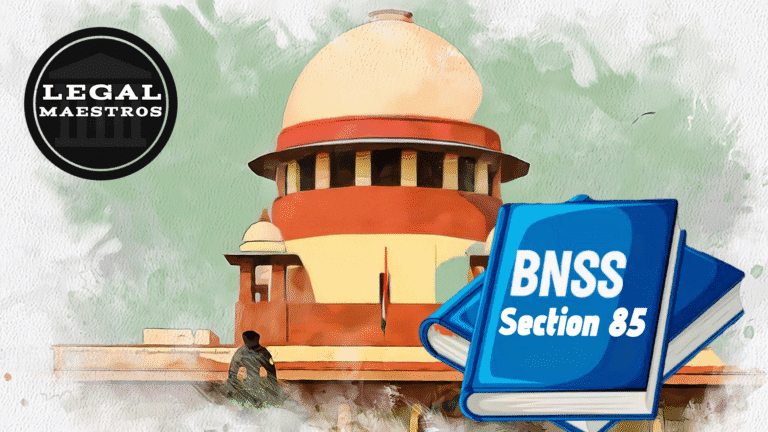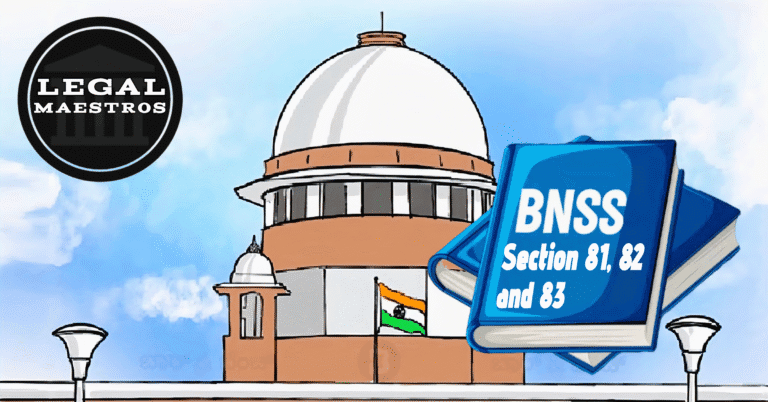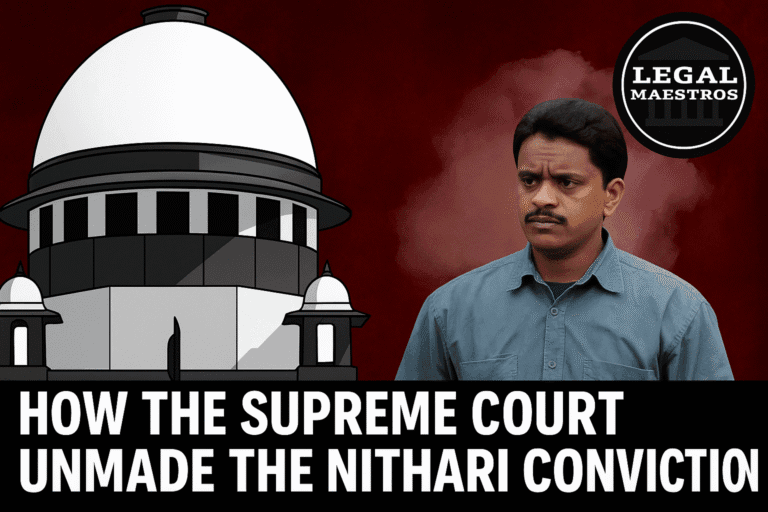
Section 36: Procedure of Arrest and Duties of Officer Making Arrest
Section 36 of the Bharatiya Nagarik Suraksha Sanhita, 2023 outlines the procedures that a law enforcement official is required to follow in order to successfully make an arrest. The incorporation of this article was done with the intention of preventing arrests that are arbitrary and unlawful, as well as protecting the rights of the individual who is being arrested.
In accordance with this clause, the first condition is that every law enforcement official who makes an arrest must be in possession of identification that is accurate, visible, and unmistakable. The wearing of a nameplate or any other kind of official identification that makes it simple for the person who was arrested and other individuals to recognize the police officer is included in this concept. It is essential to take this action in order to guarantee transparency and to offer the possibility of holding the officer accountable in the event that any misbehavior occurs either during or after the arrest.
A memorandum of arrest is the second thing that the officer is required to prepare. This memorandum is a written document that serves as confirmation that the individual in question was arrested. In addition to meeting two essential requirements, it must provide particulars that are specific. A minimum of one witness is required to vouch for its authenticity. For the best possible outcome, this witness ought to be a member of the arrested person’s family. In the event that a member of the family is unavailable, a reputable individual from the city or town in which the arrest is made may be called upon to testify as a witness. The presence of a witness helps to provide an independent account of the arrest process, which in turn reduces the likelihood that the police will abuse their authority in any way.
For any queries or to publish an article or post or advertisement on our platform, do call at +91 6377460764 or email us at contact@legalmaestros.com.
In the second step, the individual who is being arrested is required to countersign the memorandum themselves. The individual who has been arrested recognizes that the arrest has taken place in his presence and that he is aware of it by countersigning the document for the arrest. This ensures that the arrest is not carried out in a manner that is either secretive or coercive.
An additional responsibility falls on the shoulders of the law enforcement officer in the event that the memorandum is not endorsed by a member of the family. It is his responsibility to convey to the individual who has been arrested that he has the authority to disclose the arrest to a friend, relative, or any other individual of his choosing. By doing so, it is ensured that the individual who has been detained is not kept incommunicado or isolated. Providing an additional layer of safety and assisting in the prevention of abuse or disappearance while in custody, informing someone about the arrest is beneficial.
Example: [Figure] Imagine that Ramesh is taken into custody by a law enforcement officer at a local market on the suspicion that he was involved in a theft case. The cop appears to be wearing his badge, which prominently displays his name. In order to get Ramesh’s neighbor, who was present at the scene, to sign as a witness, he develops a memorandum of arrest and brings it to his attention. It is also Ramesh who signs the memorandum. Ramesh is informed by the police that he has the authority to phone his brother and alert him of the arrest. This is because the officer was unable to locate any family members who were available. Within the entirety of this procedure, legality, openness, and accountability are guaranteed.
For any queries or to publish an article or post or advertisement on our platform, do call at +91 6377460764 or email us at contact@legalmaestros.com.
Section 37: Designated Police Officer
The duties of the State Government are outlined in Section 37 of the Bharatiya Nagarik Suraksha Sanhita, 2023. These tasks include ensuring that appropriate systems are in place to monitor and record arrests. This part offers a structure that is both administrative and systemic in nature, with the purpose of tracking the arrest of individuals.
A police control room must be established in each and every district, as well as at the state level, according to the first half of this provision, which mandates that the State Government must do so. The information pertaining to police action, particularly arrests, is saved and controlled in these control rooms, which serve as major points of communication and record-keeping.
The designation of a police officer in each and every area and at each and every police station is the second prerequisite. The officer in question must hold a rank that is at least equivalent to that of an Assistant Sub-Inspector of Police. Keeping records that are up to date and include the names and addresses of those who have been arrested, as well as the information regarding the nature of the offenses for which they are charged, and making sure that this information is presented in a prominent manner are the special responsibilities of the officer who has been assigned. It is possible to show the information in any format, including digital mode, and it ought to be immediately available at both the police station and the district headquarters.
For any queries or to publish an article or post or advertisement on our platform, do call at +91 6377460764 or email us at contact@legalmaestros.com.
This public exhibition of information relating to arrests ensures that police activities are conducted in an open and honest manner. In addition, it serves the objective of alerting the general public and the relatives of the individuals who have been arrested about the whereabouts of their loved ones as well as the charges against them. In addition to that, this provision assists legal representatives and groups that advocate for human rights in monitoring the lawfulness of police operational procedures.
An illustration of this would be the Assistant Sub-Inspector at the police station recording Ramesh’s name, address, and the crime for which he is being charged (stealing) after he has been detained. This information is then posted on a notice board at the police station as well as in the district control room. Additionally, it is entered into the digital system that has been implemented at the district level. The notice that certifies that Ramesh has been detained and is currently being held in custody is presented to members of Ramesh’s family when they go to the police station. In addition to preventing unlawful detention, this system helps eliminate any misunderstanding that may exist.
Section 38: Right of Arrested Person to Meet an Advocate of His Choice During Interrogation
Section 38 of the Bharatiya Nagarik Suraksha Sanhita, 2023 is a significant legal safeguard that places an emphasis on the rights of an individual who has been arrested while they are being spoken to by law enforcement. The provision of legal support to the individual who is detained helps to ensure that they are not subjected to coercion or torture and that they are not left alone at the mercy of the authorities.
For any queries or to publish an article or post or advertisement on our platform, do call at +91 6377460764 or email us at contact@legalmaestros.com.
Individuals who have been arrested have the right to meet with an advocate of their choosing while they are being questioned by law enforcement, as stipulated by this clause. On the other hand, it makes it clear that the advocate is not permitted to be present throughout the entire process of interrogation. This indicates that the presence of the attorney is permitted at specific intervals or phases of the questioning; but, he is not permitted to permanently accompany the individual for the entirety of the interview.
In order to achieve a satisfactory equilibrium between the requirements of conducting an efficient inquiry and the safeguarding of individual rights, this provision has been drafted. Providing the detained individual with the opportunity to have a lawyer present ensures that they will not be coerced into making a false confession or exposed to any kind of mistreatment throughout the process. In the same vein, it provides the required space for the officers conducting the investigation to carry out an appropriate investigation.
Immediately upon Ramesh’s arrest, the authorities start questioning him about his supposed role in the theft case. This is illustrated by the following illustration. A request has been made by Ramesh for his attorney, Mr. Singh, to be present. Mr. Singh is permitted to meet Ramesh at various points over the course of the interrogation by the police. It is Mr. Singh’s responsibility to monitor his client’s health and make certain that he is not being mistreated in any way. Ramesh’s legal rights are safeguarded by this arrangement, which does not excessively impede the investigation being conducted by the police.
For any queries or to publish an article or post or advertisement on our platform, do call at +91 6377460764 or email us at contact@legalmaestros.com.






![Research Assistantship @ Sahibnoor Singh Sindhu, [Remote; Stipend of Rs. 7.5k; Dec 2025 & Jan 2026]: Apply by Nov 14, 2025!](https://legalmaestros.com/wp-content/uploads/2025/11/Gemini_Generated_Image_s0k4u6s0k4u6s0k4-768x707.png)
![Karanjawala & Co Hiring Freshers for Legal Counsel [Immediate Joining; Full Time Position in Delhi]: Apply Now!](https://legalmaestros.com/wp-content/uploads/2025/11/Gemini_Generated_Image_52f8mg52f8mg52f8-768x711.png)
1 thought on “Sections 36, 37 and 38 – Ensuring Transparent & Lawful Arrests under Bharatiya Nagarik Suraksha Sanhita, 2023”